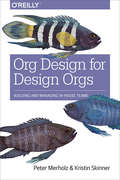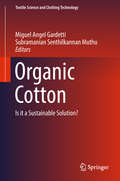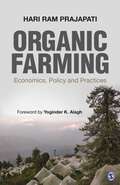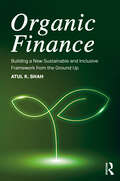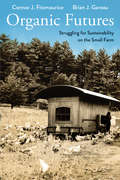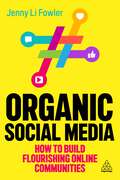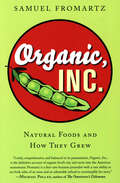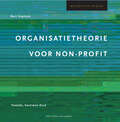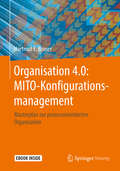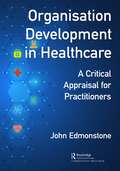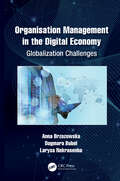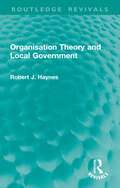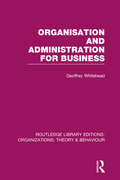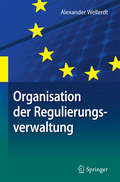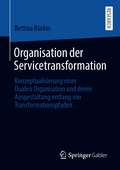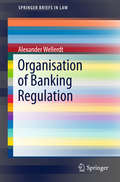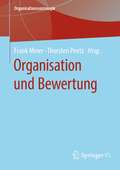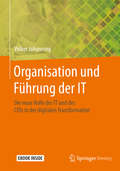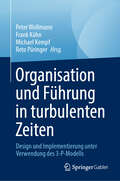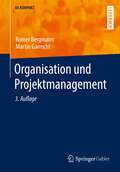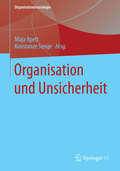- Table View
- List View
Org Design for Design Orgs: Building and Managing In-House Design Teams
by Peter Merholz Kristin SkinnerDesign has become the key link between users and today’s complex and rapidly evolving digital experiences, and designers are starting to be included in strategic conversations about the products and services that enterprises ultimately deliver. This has led to companies building in-house digital/experience design teams at unprecedented rates, but many of them don’t understand how to get the most out of their investment. This practical guide provides guidelines for creating and leading design teams within your organization, and explores ways to use design as part of broader strategic planning.You’ll discover:Why design’s role has evolved in the digital ageHow to infuse design into every product and service experienceThe 12 qualities of effective design organizationsHow to structure your design team through a Centralized PartnershipDesign team roles and evolutionThe process of recruiting and hiring designersHow to manage your design team and promote professional growth
Organic Cotton: Is it a Sustainable Solution? (Textile Science and Clothing Technology)
by Subramanian Senthilkannan Muthu Miguel Angel GardettiThis book highlights the traditional boundaries of the textile industry and discusses to what extent organic cotton is sustainable. It also examines the domestic and international influences of agricultural practices on cotton. Sustainability issues in the textile and fashion sectors require the influences that arise from beyond the boundaries of the conventional textile industry to be taken into account. These “external” influences—from (international or domestic) agricultural practices and energy policies to consumption patterns and levels of ecological notions of the society—have a significant impact on the sustainability of the textile and fashion sectors as a whole. Ecological and social concerns go far beyond individual companies and industries; therefore, in order to become more sustainable, the textile (and fashion) industry needs to address these concerns appropriately and connect with other disciplines, industries, communities, and international groups.
Organic Farming: Economics, Policy and Practices
by Hari Ram PrajapatiOrganic farming has experienced steady growth in terms of production, number of growers, area under cultivation and rise in use of organic inputs across India and Asia in general in recent times. It has gradually emerged as a viable substitute for the high-cost, high-polluting mechanized farming prevalent in many parts of the world, including India. This book starts with an extensive description of the economics of organic farming. Food products are grown by two groups—conventional growers, who target the mass market, and organic growers who target either the ‘niche urban market’ or the worldwide export market. The demand for major organic food items such as milk, meat, eggs and dairy products is growing rapidly in national urban and international markets. On the other hand, the conventional grower has a large share of both national and international markets. The book clearly differentiates between the economics of these two product and farming types. The book closely analyses why some Indian states are doing better than others and why some countries are doing better than others in Asia in organic farming. It describes the state-wise growth of the organic market in India as a result of the proactive policies and actions of states which are more successful than others. The book also presents exhaustively the international organic farming rules and regulations based on four principles—health, ecology, fairness and care, which constitute the basis for the formulation of rules and regulations by all countries, which in turn further enable the expansion and development of organic farming along scientific and democratic lines.
Organic Finance: Building a New Sustainable and Inclusive Framework from the Ground Up
by Atul K. ShahModern finance science is profoundly broken and damaging, morally and culturally. It has no choice but to change its theory and pedagogy – but the question is how and in what ways? We urgently need to see the world from a very different, kinder, gentler and more caring paradigm. In truth, the planet is bio-diverse, and so is society, with a huge tapestry of faiths, customs, beliefs and practices in finance. A holistic approach is urgently needed. This book builds a new un-anthropocentric moral and sustainable finance from the ground up, helping students, professionals and scientists to reconstruct the knowledge and connect it to indigenous beliefs and timeless wisdom. An interdisciplinary, nontechnical approach is adopted. Respect for all living beings, the protection of forests, soil and soul, and the importance of trust, culture and relationships are critical to building harmonious communities. Examples and techniques to re-engineer finance science are offered throughout the book.
Organic Futures: Struggling for Sustainability on the Small Farm
by Brian Gareau Connor J. FitzmauriceAn exploration of the lived experience of small-scale organic farmers in New England that unpacks how they balance their ideals with economic realities In recent years, the popularity of organically grown produce has exploded. In 2014, organic fruits and vegetables accounted for 12% of all produce sales in the United States, with $39 billion in consumer sales reported for 2015. As a federally recognized niche market within the agricultural mainstream, organic farming is increasingly on display in American grocery stores. Yet the organic food most Americans consume today is produced by an industrial food system at odds with the practices and ideals of small-scale farmers. Taking an ethnographic approach, the fieldwork by Connor Fitzmaurice and Brian Gareau at a small New England organic farm sheds light on how farmers navigate the difficult terrain between practices of sustainability and the economic realities of contemporary agriculture. Drawing on extensive research, Fitzmaurice and Gareau examine the historical context, complexities, and viability of nonconventional organic farming practices: practices that seek to balance ecology and community with the business of agriculture.
Organic Growth at Wal-Mart
by Jan W. Rivkin Troy SmithIn 2005, an executive vice president at Wal-Mart must decide whether to expand the retailer's selection of organic food. The decision is made in the context of wider attempts to move the giant retailer slightly upscale and to focus on environmental sustainability.
Organic Materials for Sustainable Civil Engineering
by Yves MoutonThis book provides an inventory of organic materials and products, the major components of all civil engineering projects, in terms of their scientific and technical background, including the regulations that cover their use and their predicted useful life. Such materials include: bitumen on the roads; geotextiles for retaining walls; membranes for bridges; tunnel and reservoir waterproofing; paint binders to protect metallic and concrete structures or to realize road markings; injection resins; gluing products; concrete admixtures; and composite materials.The presentation is based on a physicochemical approach, which is essential if these products are to be considered as part of sustainable development: as such, those studying or working in these fields will find this an invaluable source of information.
Organic Social Media: How to Build Flourishing Online Communities
by Jenny Li FowlerOrganizations and institutions focused on community building have a built-in group of ambassadors who embrace their message and vision. Social media managers have a unique opportunity to lean into this loyalty by creating a social presence informed by this digital engagement. In Organic Social Media, Jenny Li Fowler outlines the important steps that social media managers need to take to enhance an organization's broader growth objectives. Fowler breaks down the important questions to help readers determine the best platforms to invest in, how they can streamline the approval process and other essential strategic steps to create an organic following on social platforms.Organic Social Media explains how to elevate the key growth objectives of a brand by creating or recreating its online presence. Early chapters walk readers through the planning phase, the process of strategic goal setting, platform selection, resource management and content discovery. Later chapters focus on executing these established plans and offer a strategic way to build a content calendar and track the success of social. With this book, social media managers will future-proof the online presence of any organization.
Organic, Inc.: Natural Foods and How They Grew
by Samuel FromartzWho would have thought that a natural food supermarket could have been a financial refuge from the dot-com bust? But it had. Sales of organic food had shot up about 20 percent per year since 1990, reaching $11 billion by 2003 . . . Whole Foods managed to sidestep that fray by focusing on, well, people like me. Organic food has become a juggernaut in an otherwise sluggish food industry, growing at 20 percent a year as products like organic ketchup and corn chips vie for shelf space with conventional comestibles. But what is organic food? Is it really better for you? Where did it come from, and why are so many of us buying it? Business writer Samuel Fromartz set out to get the story behind this surprising success after he noticed that his own food choices were changing with the times. In Organic, Inc., Fromartz traces organic food back to its anti-industrial origins more than a century ago. Then he follows it forward again, casting a spotlight on the innovators who created an alternative way of producing food that took root and grew beyond their wildest expectations. In the process he captures how the industry came to risk betraying the very ideals that drove its success in a classically complex case of free-market triumph.
Organigraphs: Drawing How Companies Really Work
by Henry Mintzberg Ludo Van Der HeydenWalk into any organization and you will get a snapshot of the company in action--people and products moving every which way. But ask for a picture of the company and you will be given the org chart, with its orderly little boxes showing just the names and titles of managers. Now there's a more revealing way to depict the people and operations within an organization--an approach called the organigraph. The organigraph is not a chart. It's a map that offers an overview of the company's functions and the ways that people organize themselves at work. Perhaps most important, an organigraph can help managers see untapped competitive opportunities. Drawing on the organigraphs they created for about a dozen companies, authors Mintzberg and Van der Heyden illustrate just how valuable a tool the organigraph is. For instance, one they created for Electrocomponents, a British distributor of electrical and mechanical items, led managers to a better understanding of the company's real expertise--business-to-business relationships. As a result of that insight, the company wisely decided to expand in Asia and to increase its Internet business. As one manager says, "It allowed the company to see all sorts of new possibilities." With traditional hierarchies vanishing and newfangled--and often quite complex--organizational forms taking their place, people are struggling to understand how their companies work. What parts connect to one another? How should processes and people come together? Whose ideas have to flow where? With their flexibility and realism, organigraphs give managers a new way to answer those questions.
Organisatietheorie voor non-profit (Methodisch werken)
by D. de Bie L.J. KapteynHet boek bestaat uit twee delen. In deel I behandelen de auteurs de ontwikkelingsfasen die zich op het terrein van het personeelsbeleid hebben voorgedaan. Deze fasen worden beschreven en becommentarieerd tegen de achtergrond van veranderingen in de relatie tussen mens, arbeid, organisatie en maatschappij. De auteurs wijzen er onder meer op dat personeelsfunctionarissen zich meer moeten gaan inzetten om arbeidsorganisaties ook in bedrijfsethisch opzicht goed te laten functioneren. In deel II bespreken de auteurs de diverse aandachtsgebieden van de personeelsfunctie, zowel in hun onderlinge samenhang als in hun gerichtheid op de verwezenlijking van interne en externe organisatiedoelstellingen.
Organisation 4.0: Masterplan zur prozessorientierten Organisation
by Hartmut F. BinnerWie Unternehmen die Herausforderungen, mit denen sie konfrontiert sind, erfolgreich managen können, beschreiben unzählige Ratgeber.Dieses Buch stellt im Detail den Weg dorthin, das „Wie“, in den Vordergrund. Der Autor verfolgt dabei einen ganzheitlichen, prozessorientierten Ansatz der Organisationsentwicklung.In dem Buch wird der Weg von einer funktionsorientierten hin zu einer prozessorientierten Organisation detailliert und anhand von vielen Anwendungsbeispielen beschrieben. Der Autor stellt Modelle, Methoden, Vorgehensweisen und Tools für die Umsetzung vor. Das MITO-Modell mit seinem Methoden-Tool als generischem Methodenbaukasten wird umfassend erläutert. Bezugspunkt für das Changemanagement ist dabei nicht die vertikale, also hierarchische Organisationsstruktur, sondern, ausgehend von einer rollenbasierten Ordnungsstruktur, die horizontale Wertschöpfungskette. Erst aus dieser detaillierten rollenbasierten Beschreibung des End-to-End-Businessprozesseses ergeben sich die Prozessaufgaben und Prozessverantwortlichkeiten. Dies wiederum ermöglicht eine hohe Datendurchgängigkeit für die Prozessdigitalisierung mit neuen Technologien wie Cloud Computing, Enterprise Mobility, Social Business, Big Data in der Organisation 4.0.In dem Buch werden alle Fragen rund um das gemeinsame Führungsverständnis in einer prozessorientierten Organisation besprochen. Auch der Aufbau einer gemeinsamen Wissens- und Lernplattform zur Qualifizierung von Führungskräften und Mitarbeitern wird behandelt. Wie lassen sich Prozesse systematisch beschreiben und im Rahmen eines ganzheitlichen Business Process Management (BPM) umsetzen? Wie können funktionsorientierte Veränderungs-, Anforderungs- und Auswirkungsanalysen durch prozessorientierte Analysen ersetzt werden? Wie lässt sich eine prozessorientierte Organisation evaluieren? Das Buch analysiert diese und weitere Fragen systematisch und detailliert und vermittelt Führungskräften nicht nur das notwendige Wissen, sondern auch die Methodenkompetenz, um Changemanagement-Prozesse umzusetzen.Ob Mittelstand oder Großunternehmen – das Buch richtet sich an alle Führungskräfte in Unternehmen, die sich mit Changemanagement auseinandersetzen.
Organisation Development in Healthcare: A Critical Appraisal for OD Practitioners
by John EdmonstoneOrganisational development (OD) as a practice involves an ongoing, systematic process of implementing effective organisational change. OD is both a field of applied science focused on understanding and managing organisational change and a field of scientific study and inquiry. It is interdisciplinary in nature and draws on sociology, psychology, particularly industrial and organisational psychology, and theories of motivation, learning, and personality. Organisation Development in Healthcare: A Critical Appraisal for Practitioners provides both an overview of the evolution of OD in healthcare as a field of practice and as a challenge to its future development. It examines the underlying assumptions behind OD and tracks its historical growth in healthcare, with special attention devoted to the UK’s National Health Service. The unusual nature of healthcare organisations delivering human services through the work of professionals who are subject to emotional labor and are addressing society’s wicked problems provides a unique context. A range of challenges for healthcare OD are identified, including questions of conformists or deviant innovation; organisations as machines or systems; hierarchy versus democracy; the importance of power and emotion and possible future ways forward for healthcare OD are suggested. Examples and short case studies from both the UK and the US to illustrate the benefits of OD are included.
Organisation Management in the Digital Economy: Globalization Challenges
by Anna Brzozowska Dagmara Bubel Larysa NekrasenkoThis book highlights the essence of information technology in the modern digital world in relation to improvements and threats to organisations and e-business in the era of the digital economy. Rapid IT development has created modern business proposals such as digital and virtual currencies, crowdfunding, peer-to-peer lending, mobile banking, online investing and new payment systems. This allows organisations and firms to increase competitiveness by using financial products and services, thus increasing their value. Information technology users receive significant timesaving and a choice of investment options. At the same time, there is a new challenge for regulators who must monitor how this or that technology affects the financial sector. The authors have collected and systematised information on the models of using information technology in e-business as well as issues of applying information technology in smart organisations and public institutions. The book addresses the issues of risk management in organizations and the problems of personal and social risks resulting from the use of information technology. In addition, the book presents a review of e-commerce sectors and models as well as e-commerce tools, international payment systems and modern money systems. Risks, threats and security rules for using banking services, e-commerce and payment systems are reviewed and systematised.
Organisation Studies and Human Resource Management: An Educator's Handbook
by Kate BlackThis book advances educational understanding and practice in Organisation Studies and Human Resource Management (OSHRM). It develops new theoretical perspectives on learning in OSHRM and introduces and evaluates a range of educational approaches, methods and techniques to advance teaching and assessment and student learning in the field. Chapters are evidence-based and provide practical advice for enhancing the effectiveness of OSHRM programmes and courses in universities, colleges and human resource development settings globally. With contributions from leading educators in OSHRM, the book both advances understanding and provides practical guidance for the design of programmes, courses and classes. Importantly, it illustrates innovative classroom and virtual learning experiences that will secure student engagement; cultivate critical and creative thinking; and enhance students’ employability, leadership and enterprise capabilities. A distinctive contribution of the book lies in the inclusion of student viewpoints on the understandings and educational advances proposed by the authors. Significantly, the book demonstrates how recent changes affecting higher education, such as globalisation, mass participation and marketisation, and, most recently, the pandemic crisis, can be embraced as opportunities to advance both educational understanding and educational policy and practice in OSHRM. This book will be invaluable for university educators internationally in the fields of OSHRM and for HR developers working in management and leadership development, and the book has relevance to both groups whatever their career stage, from absolute beginners through to advanced practitioners.
Organisation Theory and Local Government (Routledge Revivals)
by Robert J. HaynesOriginally published in 1980, this book provides an analysis and assessment of events in local government management during the late 20th Century set within an overall conceptual framework of organisation theory. The book fills the gap between theoretical prescription and practical management application. The analysis focuses on three areas of organisation design and functioning – the structural, the procedural and the cultural. In each of these areas the interrelationship between broad theoretical prescriptions and the actual management innovations introduced in local authorities is examined. A major portion of the book is devoted to an assessment of the importance of behavioural/cultural factors in the introduction and assimilation (or rejection) of managerial change, an aspect of organisational functioning which was neglected in the literature on local government management.
Organisation and Administration for Business: Organizations: Organisation And Administration For Business (Routledge Library Editions: Organizations)
by Geoffrey WhiteheadThis book provides a comprehensive introduction to business organisation and administration. Written in a straightforward, readable style this textbook covers all the major aspects of the subject. Starting with the organisational background it goes on to cover the functions of the important departments within the firm, the role of the administrative officer, and other areas of knowledge vital to the smooth running of a business. There are self-assessment questions at the end of each section, past exam questions, study and exam tips and a full index.
Organisation der Regulierungsverwaltung: Am Beispiel Der Deutschen Und Unionalen Energieverwaltung
by Alexander WellerdtDieses Buch enthält eine detailreiche Untersuchung von Handlungsformen und Entscheidungsverfahren deutscher und europäischer Regulierungsakteure im Energiebinnenmarkt. Ausgehend von der Bundesnetzagentur wird insbesondere die Zusammenarbeit mit anderen nationalen Regulierungsbehörden, der Agency for the Cooperation of Energy Regulators (ACER) und der Europäischen Kommission hinsichtlich Organisation und Verfahren herausgearbeitet. Anhand einer wissenschaftlichen Einordnung der Praxisinstrumente nach Handlungsformen, Rechtswirkungen und Rechtsschutzintensität werden Modelltypen entwickelt, die das Zusammenspiel von Organisationsformen und Entscheidungsverfahren im europäischen Regulierungsverbund aufzeigen. Dieses Buch deckt Spannungen im europäischen Energiebinnenmarkt auf, indem es sich nicht auf die Feststellung rechtlicher Unstimmigkeiten im Regulierungsverbund beschränkt, sondern aktuelle Praxisprobleme aufgreift und zukünftige Entwicklungen durch das Vierte Energiebinnenmarktpaket antizipiert.
Organisation der Servicetransformation: Konzeptualisierung einer Dualen Organisation und deren Ausgestaltung entlang von Transformationspfaden
by Bettina BürkinDie hohe Bedeutung von Dienstleistungen für das Leistungsangebot produktorientierter Unternehmen erfordert eine grundlegende strategische Veränderung dieser Unternehmen, mit Konsequenzen für ihren organisatorischen und strukturellen Aufbau. Bettina Bürkin entwickelt in dieser Arbeit ein ganzheitliches Transformationsmodell mit dem Schwerpunkt der Dualität für diese Servicetransformation und leistet so einen konzeptionellen und praktischen Beitrag zur Umsetzung dienstleistungsorientierter Strategien in produktorientierten Unternehmen. Dazu findet eine intensive Auseinandersetzung mit den konzeptionellen Grundlagen und den Besonderheiten der Servicetransformation statt. Des Weiteren werden im Rahmen einer organisationstheoretischen Analyse die Kontingenztheorie, Ambidextrie und Dualitätstheorie im Hinblick auf ihren theoretischen Erklärungsbeitrag für die Duale Organisation für die Servicetransformation bewertet. Die Autorin zeigt weiterhin anhand zweier idealtypischer Transformationspfade die Anwendung des Transformationsmodells für unterschiedliche Organisationsformen und -kontexte. Auf Basis ihrer konzeptionellen Arbeit und den Ergebnissen einer qualitativen Untersuchung werden schließlich Handlungsempfehlungen für die reflektierte, situationsspezifische Vorbereitung und Anwendung des Transformationsmodells gegeben.
Organisation of Banking Regulation
by Alexander WellerdtThis book illustrates the interaction of banking regulators and discusses with it related legal and economic challenges. First, the importance of administrative organisations for the implementation of regulatory law towards banks and financial institutions is shown. On this basis five model types of administrative organisations in the field of banking regulation are derived. Thereby, banking regulators can be classified due to their influence on regulatory decisions. Their influence runs from preparation across enforcement to control of regulatory decisions. In particular, the cooperation of the European Central Bank with national banking regulators is analysed. Finally, the main legal and economic arguments of Banking Regulation in the Economic and Monetary Union are discussed.
Organisation und Bewertung (Organisationssoziologie)
by Frank Meier Thorsten PeetzOrganisationen spielen für viele Bewertungsprozesse eine entscheidende, aber oft übersehene Rolle: Sie geben den Kontext ab, in dem Bewertungen vollzogen werden, sie produzieren und kommunizieren Bewertungen und werden schließlich auch selbst regelmäßig bewertet, evaluiert, geratet und gerankt. Die Beiträge des Bandes verknüpfen systematisch Ansätze aus Organisationsforschung und Valuation Studies und eröffnen dadurch einen dezidiert organisationssoziologischen Blick auf Phänomene des Bewertens, Vermessens, Kategorisierens und Vergleichens in, von und durch Organisationen.
Organisation und Führung der IT: Die neue Rolle der IT und des CIOs in der digitalen Transformation
by Volker JohanningDas Buch zeigt praxisnah wie sich IT-Organisationen optimal aufstellen müssen in dieser sich dynamisch wandelnden Welt und was dies für die Führung dieser immer wichtiger werdenden IT bedeutet. Darüber hinaus wird das Thema Führung einer IT-Organisation näher beleuchtet: Was ist die Rolle und was sind die Führungsaufgaben eines CIOs? Wie und mit welchen Mitteln kann eine IT-Organisation am besten gesteuert werden? Wie können komplexe Veränderungsprozesse und Transformationen geführt werden? Somit bietet das Buch eine praxisorientierte Anleitung für die Organisationsänderung oder Reorganisation der IT mit vielen Tipps zu Change-Management, Führung sowie agilen Methoden und Ansätzen in der neuen IT-Organisation.
Organisation und Führung in turbulenten Zeiten: Entwurf und Implementierung unter Verwendung des 3-P-Modells
by Peter Wollmann Frank Kühn Michael Kempf Reto PüringerDieses Buch knüpft an die erfolgreiche Entwicklung des Drei-Säulen-Modells (3-P-Modell) der Autoren für die Organisation und Führung in disruptiven Zeiten an. Der Schwerpunkt liegt darauf, dem Leser bei der Umsetzung des Modells zu helfen und eine Vielzahl von Anwendungsfällen für diese VUCA-Zeiten (Volatilität, Ungewissheit, Komplexität und Mehrdeutigkeit), einschließlich globaler Krisen wie der COVID-19-Pandemie, zu liefern. Das Buch deckt ein breites Spektrum von Organisationen ab: privater und öffentlicher Sektor, Nichtregierungsorganisationen, lokale und globale Regierungsinstitutionen, globale Organisationen wie die UNO usw. Darüber hinaus wird aufgezeigt, wie das 3-P-Modell auf Herausforderungen bei der Organisationsgestaltung, dem Management und der Führung angewendet werden kann.
Organisation und Projektmanagement (BA KOMPAKT)
by Rainer Bergmann Martin GarrechtAnschaulich und praxisnah zeigen die Autoren in diesem Lehrbuch, wie Organisationen funktionieren, wie sie gestaltet werden können und wie Projekte gemanagt werden: von der Aufbauorganisation und der Gestaltung von Prozessen über die Organisationskultur bis hin zur Arbeit in Projektteams. Warum Unternehmen heute so unterschiedlich gestaltet sind, zeigt ein Überblick über die Organisationstheorien von der wissenschaftlichen Betriebsführung und ihrer aktuellen Bedeutung im digitalen Taylorismus bis zu aktuellen Managementkonzepten (z. B. Organisation in Netzwerken, Shared Service Centern, Selbstorganisation oder Change Management) und deren kritischer Würdigung vor dem Hintergrund der Entwicklung von Managementmoden.Anschauliche Fallstudien und Praxisbeispiele zu jedem Themenblock regen die Diskussion im Anwendungszusammenhang an. Das Buch deckt vollständig die Anforderungen ab, die für das Modul "Organisation und Projektmanagement" in Bachelor-Studiengängen gestellt werden.Die dritte Auflage wurde um diverse Abschnitte zu neuen Managementkonzepten (u. a. agiles Projektmanagement, flache Hierarchien, Holakratie, evolutionäre Organisation) und um zahlreiche Praxis- und Fallbeispiele erweitert sowie umfassend aktualisiert und ergänzt.
Organisation und Unsicherheit
by Maja Apelt Konstanze SengeDas Buch ,,Organisation und Unsicherheit" geht der Frage nach, wie Organisationen in der Gegenwart auf Unsicherheiten reagieren. Diese Unsicherheiten können organisationsintern erzeugt werden oder aus der Organisationsumwelt resultieren. Aus unterschiedlichen theoretischen Perspektiven und anhand verschiedener empirischer Analysen zu Jugendämtern, Bildungseinrichtungen, High Reliability Organisationen und Organisationen des Finanzmarktes u. a. m. wird gezeigt, welche Konsequenzen sich aus zunehmenden Unsicherheiten für das Handeln in Organisationen und die Beziehungen zwischen Organisationen und Umwelt ergeben. Versuche, Unsicherheit zu vermeiden oder zu beseitigen, führen dabei - wie viele der Beiträge zeigen - zu neuen Unsicherheiten.
